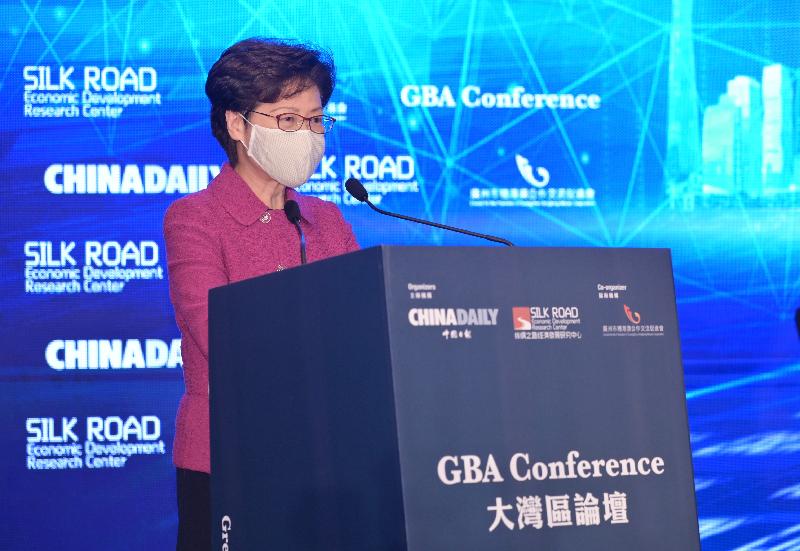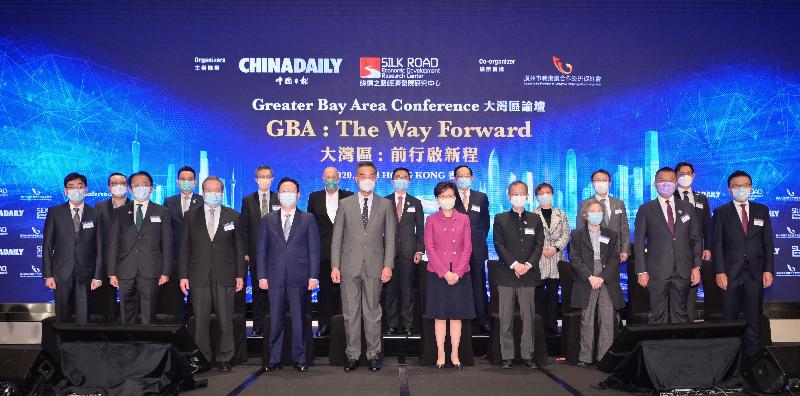Following is the speech by the Chief Executive, Mrs Carrie Lam, at the Greater Bay Area Conference – GBA: The Way Forward today (November 18):
The Honourable C Y Leung (Vice-Chairman of the National Committee of the Chinese People’s Political Consultative Conference), Deputy Director Tan Tieniu (Deputy Director of the Liaison Office of the Central People’s Government in the Hong Kong Special Administrative Region), Mr Joseph Chan (Chairman of the Silk Road Economic Development Research Center), Mr Zhou Li (Deputy Editor-in-Chief of China Daily Group and the Publisher and Editor-in-Chief of China Daily Asia Pacific), ladies and gentlemen,
Good morning. It gives me great pleasure to be here today at this Greater Bay Area Conference co-organised by China Daily and Silk Road Economic Development Research Center. Themed “GBA: The Way Forward”, the Conference has brought together a group of distinguished people to speak on aspects of healthcare, technology and emerging opportunities. The speakers are not only highly qualified in their respective fields, but they all share one thing in common, and that is they all agree that the Guangdong-Hong Kong-Macao Greater Bay Area (GBA) is of great potential and will offer abundant development opportunities for Hong Kong.
In order for the people of Hong Kong to grasp those opportunities, they need to have a good understanding of the GBA and its latest development. To this end, I have to thank China Daily for producing those highly informative reports entitled “GBA Focus” on a regular basis. I have the habit of keeping copies of those reports in a folder for easy reference and may take the initiative to connect the Government with people and institutions mentioned in those reports. For example, having read the “GBA Focus” edition on healthcare which appeared in China Daily on October 23, I told the Secretary for Food and Health that we should have a chat with Mr Carl Wu of the New Frontier Group, which is planning to invest more in the healthcare services in the GBA.
I spoke at this Conference three years ago when I mentioned the far-reaching promise of the GBA. Today, I am even more convinced that the GBA will not only provide a huge market for Hong Kong’s professional services, but will be our best conduit to integrate into the latest “dual circulation” in the Mainland’s development blueprint.
Much has happened with the GBA development since that exposition three years ago. Let me just recap the key milestones:
- In August 2018, a GBA Leading Group chaired by Vice Premier Han Zheng was set up and for the first time the Chief Executives of the Hong Kong SAR and the Macao SAR are made members of this important institution of the Central Authorities;
- In February 2019, the Outline Development Plan for the Guangdong-Hong Kong-Macao Greater Bay Area was officially promulgated by the State Council;
- In March and November 2019, two plenary meetings of the GBA Leading Group were held with a total of 24 specific measures to support the GBA development announced. By now, half of these have been fully implemented, providing facilitation in terms of income tax, Hong Kong people buying residential properties, R&D funding to Hong Kong tertiary institutions, etc. I realise that amongst the outstanding measures are a couple of health-related measures and I have my medical friends on the panel and in the audience. I want to tell you, good news is on the horizon;
- In September and October 2019 and August 2020, three important pieces of cross-boundary infrastructure, namely the Hong Kong Section of the Guangzhou-Shenzhen-Hong Kong Express Rail Link, the Hong Kong-Zhuhai-Macao Bridge and the cargo clearance facilities at the Liantang Port/Heung Yuen Wai Boundary Control Point, were respectively commissioned, moving towards the goal of a one-hour travelling zone;
- Up to this month, at least 10 Central Government ministries and commissions have published frameworks, opinions or arrangements to support the GBA, covering a wide range of subjects such as finance, technology, aviation, trade, meteorological development, infrastructure connectivity planning as well as construction services;
- In June 2018 and April 2019, the three governments of Guangdong, Hong Kong and Macao organised overseas promotion of the GBA in Paris and Tokyo respectively; and
- To date, several universities in Hong Kong have embarked on campus projects in the GBA, notably that of the Hong Kong University of Science and Technology at Nansha, Guangzhou, and the Chinese University of Hong Kong’s medical school at Shenzhen.
​ With President Xi Jinping reiterating the historic importance of the GBA as a major national development strategy in his keynote speech made at Shenzhen on the occasion of celebrating the 40th anniversary of the Shenzhen Special Economic Zone, and Vice Premier Han Zheng’s extremely positive remarks made in meeting with me and my delegation in Beijing earlier this month, I think we could expect more favourable policies and support measures for Hong Kong to take part in the GBA.
As a matter of fact, with the COVID-19 pandemic plaguing the global economy and Hong Kong suffering from a severe recession, our economic recovery lies in co-operating more fully with the Mainland, which has regained its economic momentum thanks to the nation’s rigorous epidemic control and prevention measures. The benefits to Hong Kong are obvious, as evidenced in our improved third-quarter economic data released last week. Real GDP registered a year-on-year decline of 3.5 per cent, which is visibly narrower than the 9 per cent contraction in the second quarter. On a seasonally adjusted quarter-to-quarter comparison, real GDP actually rebounded by 2.8 per cent in the third quarter, arresting the declines in the preceding five quarters. It underscores the importance for Hong Kong to better integrate into the nation’s overall development, and there is no better way to achieve this than vigorously participating in the development of the GBA. However, to do that we have to first restore normal cross-boundary flow of people, and let me assure you that the Hong Kong SAR Government is doing its utmost in fighting the virus.
Apart from discussion on the resumption of travel, I suppose some of you are keen to know what are those support measures that I have obtained from the Central Government during my recent trip to Beijing, Guangzhou and Shenzhen. While I shall have to beg for your patience until the 2020 Policy Address to be delivered on November 25, I wish to share with you what I consider to be important principles in guiding Hong Kong’s participation in the GBA.
First, adherence to the “One Country, Two Systems” policy. As it has been stated explicitly in the GBA Outline Development Plan, the GBA should leverage on this unique arrangement of one country, two systems, three customs jurisdictions, three legal systems, etc. Hong Kong should continue to offer the GBA our traditional advantages of an established international business environment, world-class financial and professional services, a low and simple tax regime, free flow of capital, the rule of law and judicial independence. It is therefore erroneous to say that Hong Kong will be marginalised by the GBA or become just another Mainland city. On the contrary, the successful development of the GBA will enrich the implementation of “One Country, Two Systems” by bringing even more long-term prosperity and stability to the Hong Kong SAR.
Second, mutual co-operation and win-win arrangement. The nine Mainland cities and Macao all have their respective strengths and contributions to make towards building a prosperous, innovative and global bay area economy. Unhelpful competition should be minimised while synergy should be created. Our mindset should be that of “one plus one is bigger than two”.
Third, innovation and technology should be put at the top of our agenda. This calls for out-of-the-box thinking in our co-operation with the Mainland cities, particularly with our neighbour, Shenzhen. With the recent reform measures and the first batch of delegated authorities given to Shenzhen, Hong Kong should play a more proactive role in identifying new opportunities for joint actions. This is one area that I have accorded personal attention to given my close involvement in Hong Kong-Shenzhen matters for over a decade.
Fourth, greater emphasis should be placed on supporting young people and nurturing talents. After all, the GBA is a long-term venture and its growth has to be propelled by a new generation who will share our passion.
Ladies and gentlemen, the Central Government has given and will continue to give the Hong Kong SAR unwavering support in developing our economy and improving people’s livelihood. What we have to do is to operate within the framework of “One Country, Two Systems”, uphold the Constitution of the People’s Republic of China and the Basic Law, and safeguard national security. It is up to us to turn those support measures into opportunities, and such opportunities are so abundantly available in the GBA. Rest assured, I and my governing team are doing all we can to grasp these opportunities. This is for the future of Hong Kong, our businesses, our community and our young people. I am sure we will have your support on this.
I wish you all a very rewarding conference and the best of business and health in the year 2021. Thank you very much.
read more



